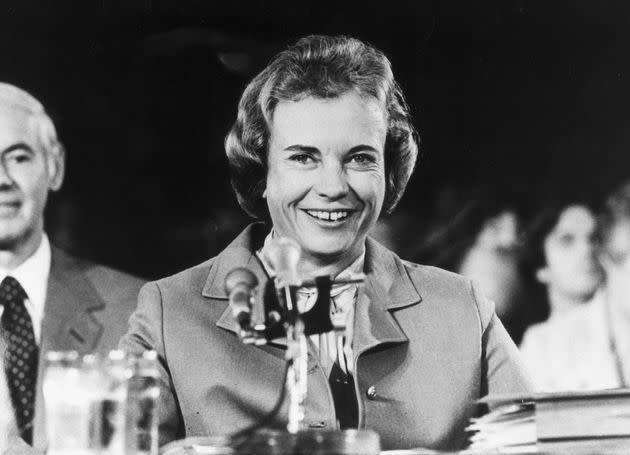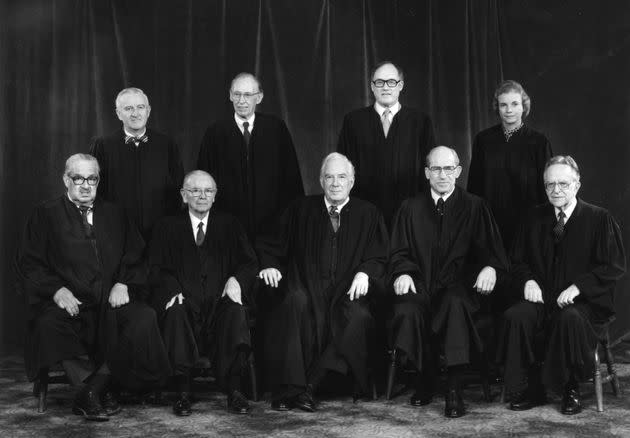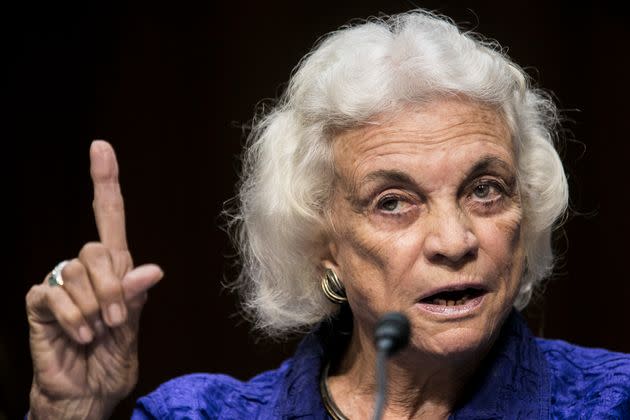Sandra Day O’Connor, First Woman On The Supreme Court, Dies

- Oops!Something went wrong.Please try again later.
- Oops!Something went wrong.Please try again later.
- Oops!Something went wrong.Please try again later.
- Oops!Something went wrong.Please try again later.
Sandra Day O’Connor, the first woman to serve on the Supreme Court, died at age 93, the court announced Friday.
The woman who often referred to herself as FWOTSC (First Woman on the Supreme Court) was a justice for 26 years, serving as the swing vote in cases addressing abortion and affirmative action. (O’Connor, however, hated the term “swing vote,” saying it suggested a person who made their rulings on a whim.) She retired from the court in 2006.
“My appointment just opened the doors, and it was not only in the United States,” O’Connor said in 2012. “It immediately had an effect in other parts of the world, with opportunities for women. It was quite amazing to see.”
When the former associate justice announced she was retiring from public life in 2018, Chief Justice John Roberts praised her legacy.
“Justice O’Connor is of course a towering figure in the history of the United States and indeed the world,” he wrote. “She broke down barriers for women in the legal profession to the betterment of that profession and the country as a whole. She serves as a role model not only for girls and women, but for all those committed to equal justice under law.”
O’Connor was born March 26, 1930, and grew up on a cattle ranch in Arizona, an upbringing that she would later say shaped her views and her judicial philosophy. In 2002, O’Connor published a book, “Lazy B: Growing up on a Cattle Ranch in the American Southwest,” with her brother, H. Alan Day, about their childhood.

Sandra Day O'Connor testifies before the Senate Judiciary Committee in September 1981 during her confirmation hearing for her nomination to the Supreme Court.
O’Connor lived with her grandmother in El Paso, Texas, throughout most of the years she was in school, returning to the ranch for summers. She graduated high school at age 16 and went to Stanford University, where she graduated magna cum laude with a bachelor’s in economics in 1950 and with a law degree in 1952.
O’Connor was initially rejected by a number of law firms because she was a woman. She finally found a job at the San Mateo County Attorney’s Office in California, where she offered to work for no pay and was given a desk near the secretary.
“Eventually, I did start getting a salary,” O’Connor recalled at a women and leadership conference in 2013. “I spent those years working through the problems women had ... like getting a job, and having gotten one, getting paid for it. Very few of my male classmates had that experience.”
She served as an assistant attorney general for Arizona beginning in 1965. O’Connor was appointed to the state Senate in 1969, then won reelection twice as a Republican. In 1972, she became the first woman to serve as a state Senate majority leader anywhere in the U.S.
O’Connor was then elected to a county judgeship and, in 1979, was appointed to the Arizona Court of Appeals. Two years later, President Ronald Reagan nominated her for a vacancy on the U.S. Supreme Court.

The justices on the U.S. Supreme Court in 1983. Back row, from left: John Paul Stevens, Lewis F. Powell Jr., William Rehnquist and Sandra Day O'Connor. Front row, from left: Thurgood Marshall, William J. Brennan Jr., Chief Justice Warren Burger, Byron White and Harry A. Blackmun.
Both conservatives and liberals approached the nomination cautiously. Conservatives were concerned about O’Connor’s lack of federal judicial experience and wary of her views on abortion, which she was unwilling to declare. Liberals were interested in the possibility of a female justice on the court, but worried that O’Connor herself wasn’t a strong feminist. In the end, the Senate approved O’Connor unanimously.
As the first woman on the court, O’Connor believed a certain responsibility came with the position. Reflecting on it years later, she said, “If I did not do the job well enough, there might be no second woman on the court.” Ruth Bader Ginsburg joined O’Connor in 1993 as the second female justice on the bench.
Despite her legislative work as a member of the Republican Party, O’Connor was often seen as an unpredictable vote on the court. She wrote the majority opinion in Mississippi University for Women v. Hogan in 1982, in which the court ruled it was unconstitutional for a state nursing school not to allow men to attend.
Such a policy “tends to perpetuate the stereotyped view of nursing as an exclusively woman’s job,” O’Connor wrote. She also cast a deciding vote for the ruling against affirmative action in 1995’s Adarand v. Pena.
O’Connor’s rulings in abortion cases also attracted attention. She wrote the majority opinion in 1992’s Planned Parenthood v. Casey, which reaffirmed a woman’s right to an abortion as decided in Roe v. Wade. At the same time, that ruling found that mandatory waiting periods before an abortion, as well as laws to protect the life and health of the fetus and mother, were constitutional.
While announcing the decision, O’Connor said: “Some of us as individuals find abortion offensive to our most basic principles of morality. But that can’t control our decision. Our obligation is to define the liberty of all, not to mandate our own moral code.”

O'Connor testifies before the Senate Judiciary Committee on July 25, 2012, where she spoke on the importance of civics education in maintaining an independent judiciary. After retiring from the court in 2006, O'Connor founded iCivics, a nonprofit that provides educational resources about civics.
In a 2013 interview with the Chicago Tribune, O’Connor cited Bush v. Gore, the dispute over votes in Florida during the 2000 presidential election, as the most controversial case the court addressed while she was on the bench.
“Maybe the court should have said, ‘We’re not going to take it, goodbye,’” she said, noting that the court ended up giving itself “a less than perfect reputation” as a result of its involvement.
O’Connor was responsible for a key line in the Bush v. Gore decision that clarified the ruling applied only “to the present circumstances,” according to the 2019 biography “First” by Evan Thomas.
She retired from the court in 2006 to care for her husband, John, who had Alzheimer’s disease. The couple moved to Arizona, where John died in 2009.
O’Connor later expressed dismay that she turned in her retirement letter just months before Chief Justice William Rehnquist died. The two had dated while at Stanford Law School and ― it was later revealed ― he even proposed to her then. But when they spoke in June 2005, while Rehnquist was suffering from thyroid cancer and O’Connor was debating retirement, the chief justice told O’Connor that he expected to stay on the court another year, which was a factor in her decision to announce her retirement that year so as to not create two vacancies at once.
“According to two friends who knew her well,” Thomas wrote in the biography, “she was bothered by a troubling thought: In their tortured conversations about who should go first, had the chief justice been fully honest with her? He had not told her the severity of his disease; she did not know that his doctors had given him no more than a year to live when he was diagnosed in October 2004.”
O’Connor wasn’t pleased with Justice Samuel Alito (her conservative replacement on the court) or the court’s right-ward drift, which undid some of her rulings after she left. “What would you feel?” she responded to a question on the matter in 2009. “I’d be a little bit disappointed. If you think you’ve been helpful, and then it’s dismantled, you think, ‘Oh, dear.’ But life goes on. It’s not always positive.”
After retiring from the court, O’Connor founded iCivics, a nonprofit that provides educational resources to teach children about civics using games. She was recognized as one of Time magazine’s 100 Most Influential People in the World in 2017, with iCivics featured prominently in the accompanying tribute, written by Supreme Court Justice Sonia Sotomayor.
She continued to enjoy listening to oral arguments at the Supreme Court whenever she was in D.C.
“When I go and sit in the courtroom and look at the bench and see three women, it perks me up,” she told the Chicago Tribune in 2013, referring to Ginsburg and two newer female associate justices, Sotomayor and Elena Kagan.
In a 2018 letter announcing that she suffered from dementia and would be retiring from public life, O’Connor expressed her hope that others would step in to promote the importance of civics.
“I feel so strongly about the topic because I’ve seen first-hand how vital it is for all citizens to understand our Constitution and unique system of government, and participate actively in their communities,” she wrote.
The former associate justice was awarded the Presidential Medal of Freedom in August 2009. To mark O’Connor’s 90th birthday in 2020, the Sandra Day O’Connor Institute posted an online archive of her work. And in early 2022, Congress passed legislation to honor O'Connor and Ginsburg with statues in the U.S. Capitol.
O’Connor summed up her legacy in a 2012 conversation with Makers: “I think of myself as an old lady who’s had a pretty darn good career.”

